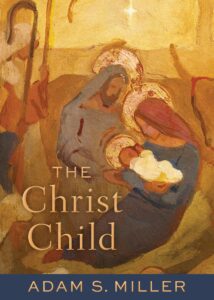Title: The Christ Child
Author: Adam S. Miller
Publisher: Deseret Book
Genre: Religious Nonfiction
Year Published: 2024
Number of Pages: 69
ISBN: 9781649333391
Price: 10.99
Reviewed by Kylie Turley
The Christ Child begins with Adam S. Miller posing Nicodemus’s question anew: “How can I be born again when I’m already old?” (9). To answer the question, Miller embraces theology, psychology, and neuroscience, and then relates his findings in both personal narrative “snapshots” and readable prose. Miller’s mixed genre writing style displays his insights in a short book that speaks to both heart and mind.
In The Christ Child, Miller does not simply list laudable Christlike qualities that children supposedly have and adults supposedly do not. Instead of that traditional approach, Miller steps back and considers whether becoming like a child means seeing the world through miniature adult eyes. Spoiler alert: It does not. Children are not little adults, but different creatures altogether. Miller tells his readers that children’s “brains work differently” (10), and then explores how children see, understand, and experience the world around them. They do so through imaginative, curious eyes, differing from adults in substantial ways.
Each chapter begins with Miller’s vivid description of a photograph of a Christmas. The scenes can be appreciated sentimentally as lovely memories of Christmases past and present. And yet, it seems likely that Miller is more purposeful. Miller is an adult, describing what he sees in a photograph. But he is also in the photograph (usually) and often as a child. Miller’s descriptions function as a metaphor. For a moment, Miller is both young and old, both the observed and the observer. Joy, curiosity, and nostalgia are woven through these descriptions, and it becomes difficult to tell which version of Miller is feeling which emotion. The mixing of past and present folds time in on itself, making Miller a child again, giving a literalness to the metaphor of becoming like a child, which is an idea worthy of contemplation.
These ideas make so much sense that readers may finish The Christ Child wondering if they have always, already known this. That is doubtful, although understandable. Writing as both friend and philosopher, Miller’s work resonates with inviting familiarity even while discussing novel insights. Then again, every adult has already experienced childhood, so perhaps Miller is simply reminding them how the world appears to children, something they have always known but have forgotten.
The Christ Child ends with a list of thought-provoking questions. Some readers may smile, bemused by Miller’s apt rhetorical choice. Other readers will pause and revel in the questions with child-like delight, asking themselves new questions before the old ones are even answered. Regardless of the individual reaction, readers will be well-rewarded if they read Adam Miller’s The Christ Child because when Miller asks himself Nicodemus’s question, he invites all of us to do likewise. His answer is a beautiful and thoughtful meditation on being born again and becoming as a child. The book invites readers to find their truths, and to observe the world through a child’s eyes. We must be reborn. Jesus said so. The question is whether we dare to see–and to be–as a child, as the Christ Child.

